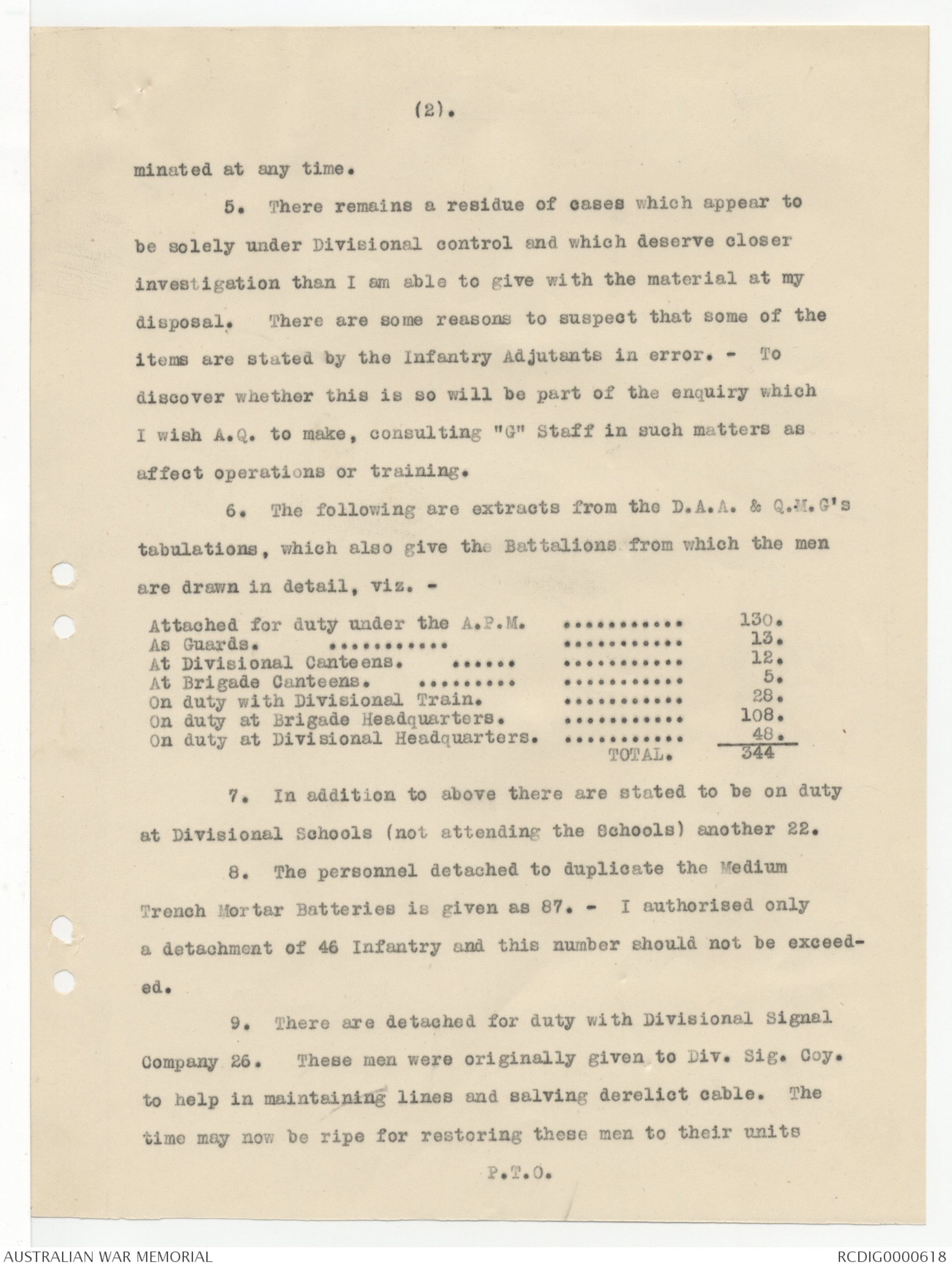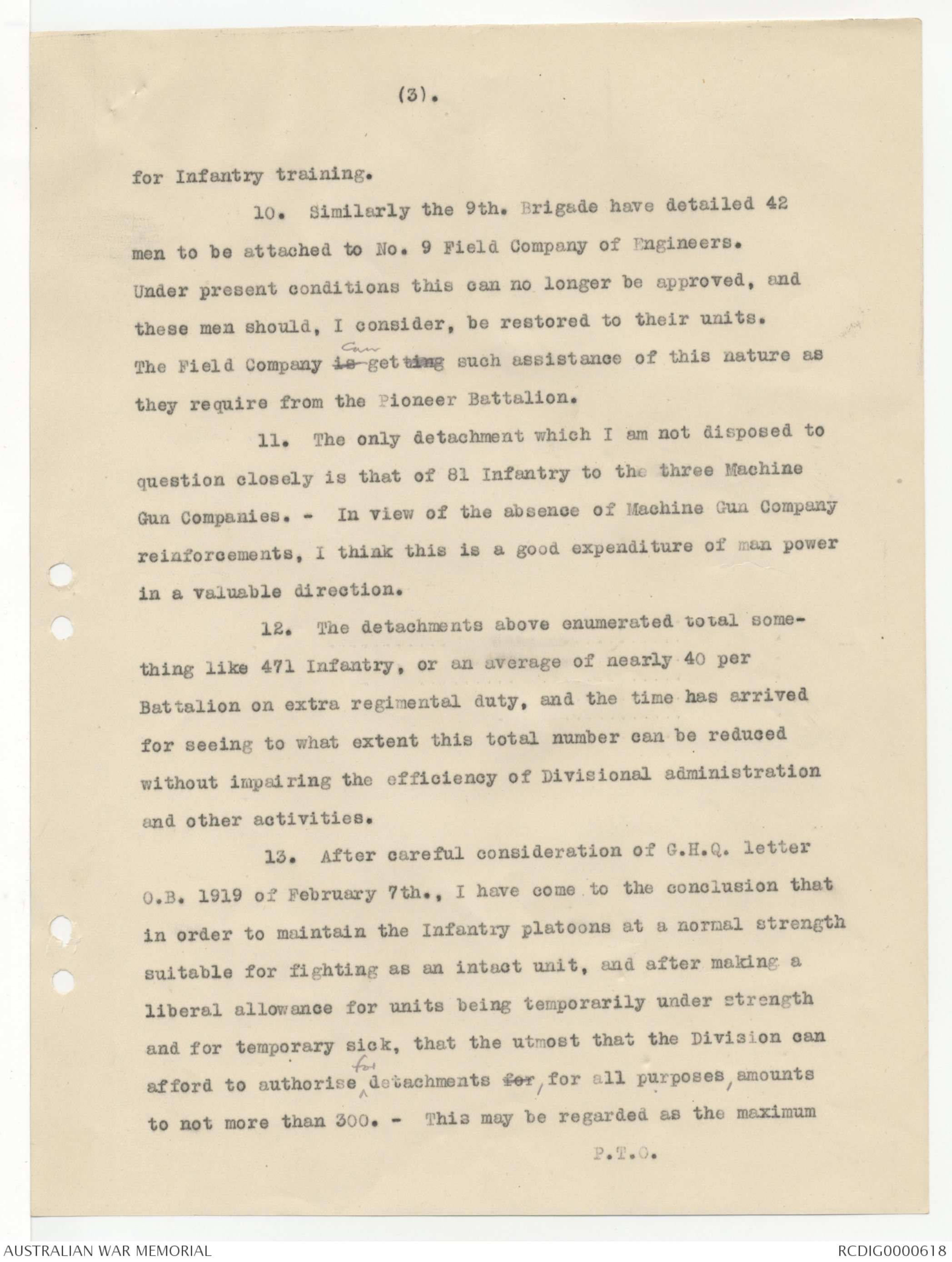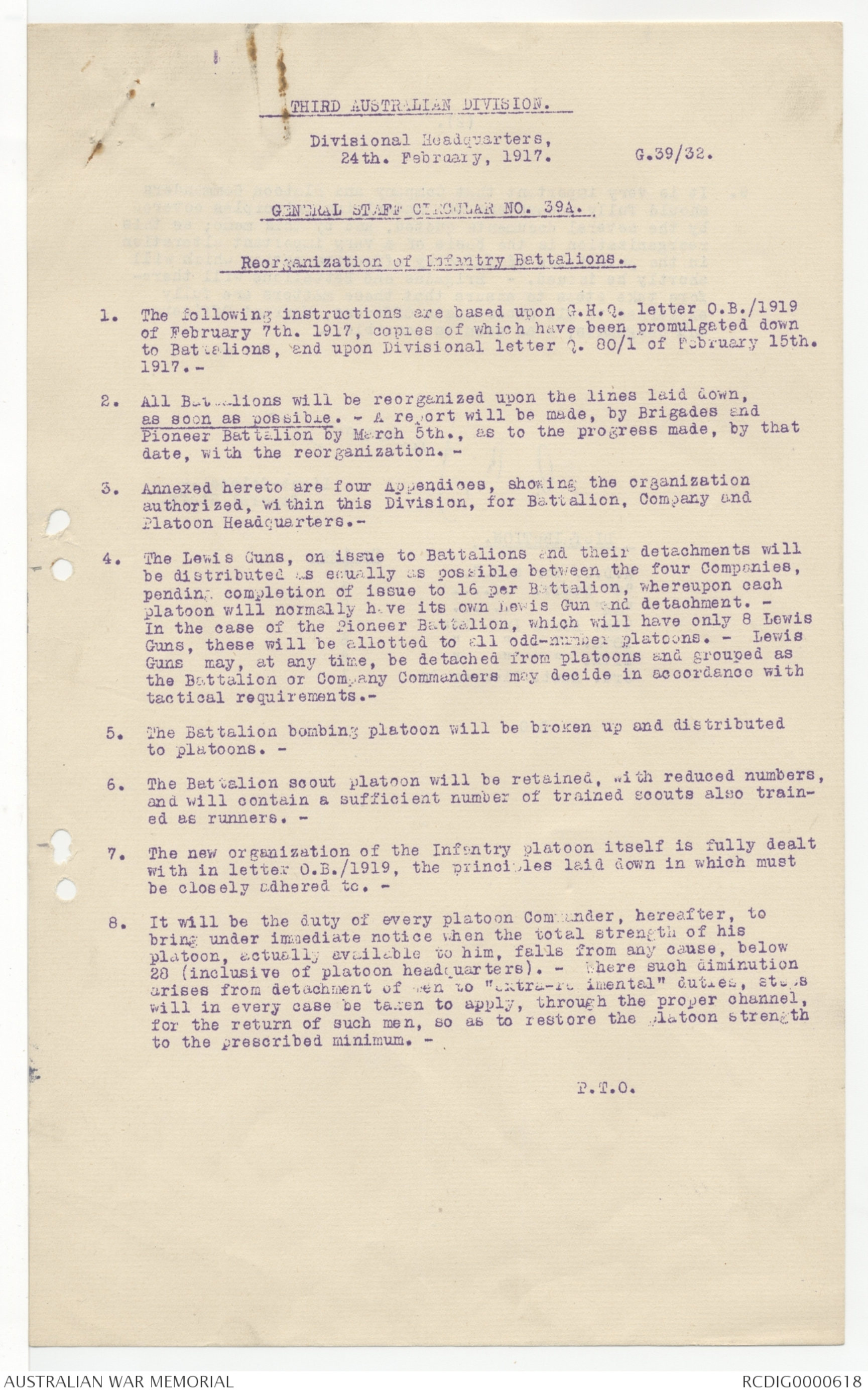Sir John Monash, Personal Files Book 14, 10 February - 30 March 1917, Part 6










This letter by LtCol Jackson
was not sent.
THIRD AUSTRALIAN DIVISION.
Divisional Headquarters,
23rd. February, 1917.
Brigadier-General McNicoll, D.S.O.
10th. Aust. Inf. Bde.-
Dear General. -
Re your B.M. 926/124 of 23rd. February.
You happen to have struck two of the Divisional Commander's
own drafts, and as usual he is absolutely right, although
your letter of the 23rd. appears to attempt to prove the
contrary.
In his Agenda Paper the G.O.C. referred to
your having to do with orders re medical arrangements.
This is confirmed by Divisional Order No. 16, but in the
G.O.C's ruling, 6/1 of the 22nd. February, he says the
A.D.M.S. is responsible for evacuation of wounded, &c.
While it is up to the A.D.M.S. to arrange for the evacuation
of wounded, it is up to you to put such of his instructions
as you think necessary into your orders. The A.D.M.S.
can't issue orders to your men nor can you, without authority,
turn down the A.D.M.S! arrangements. The question
of one man's instructions going into another man's orders
is clearly dealt with in F.S.R. II, page 42, Section 173.
Quite a normal proceeding in fact. Apart from this there
are your own stretcher bearers, carrying parties and system
of getting the wounded back to the Doctors, which I don't
suppose the A.D.M.S. will want to interfere with in the
least.
I have pointed out to General MONASH that the
penning of B.M. 926/124 was probably due to a slight lack of
familiarity with Staff work, and not a desire to indicate to
the Divisional Commander that he was wrong and had contradicted
P.T.O
(2).
himself. I think we all fully realise that we are
not here to teach our superiors how to act, but rather to
interpret their orders loyally, so long as the orders are
sufficiently clear to enable this to be done.
Yours sincerely.-
DUNTROON GRADUATES.
List of Senior Duntroon Graduates( showing Royal Military College
Seniority) now with 1st & 2nd A. & N.Z. Army Corps. (Mounted
Division not included).
| Div. | Rank & Name | Present appointment | Present employment (if detached from Unit) |
REMARKS. |
|---|---|---|---|---|
| 1st | Capt CLOWES N. |
Staff Capt. 1/Div. Arty. |
(on Staff Course Hesdin) |
|
| 2nd | Capt. CLOWES A.C. |
O.C. 10/Bty 2/Div. Arty |
||
| 1st | Major BROWN D.R.(M.C.) | 4th Batt |
(on Staff Course Cambridge) |
|
| 3rd | Major WOOTTEN G. F. |
Bde. Major 11/Bde |
||
| 4th | Major STEELE W.A.B. |
Senior Major 52nd Btn. |
||
| 1st | Capt. FORBES A.M. |
O.C. 102nd How. Bty. |
||
| 3rd | Capt. IRWIN J.M. |
Staff Capt. 3/Div. Arty. |
||
| 5th | Capt. NEWMARCH J.H. (M.C.) |
5th Div. Arty. |
(Sick in England) | |
| 1st | Major BOASE A.J. | 12th Batt. |
Att. "Q" 1/Anzac. |
|
| 3rd | Major PAIN J. H.F (M.C.) |
G.S.O III 3/DIV. |
||
| 5th | Capt. VOWLES E.L. |
O.C. Bty., 5/Div. Art. |
(on Staff Course Cambridge) |
|
| 2nd | Capt. MORGAN P. J. |
Staff Capt. 2/Div. Arty |
||
| II Anzac. | Capt. DUNLOP W.A.S. | Adjt. 4/L.H. | ||
| 4th | Major LOCKE W.J.M. | 13th Btn. |
Att. "G" 1/Anzac. |
|
| 4th | Major WILTON E.A. |
O.C. 4th M.G. Coy |
(Sick in England) | |
| 5th | Capt. LEGGE R.G. | 59th Batn. | ||
| 4th | Major LEE, J.E. (M.C) | 45th Batn. | (Sick 4-12-16) | |
| 4th. | Capt. KENNEDY, M.S. | 52nd Batn. |
(On Staff Course Cambridge). |
|
| 2nd. | Capt. BEAVIS, L.E. |
Adj. Bde. 2/Div.Art. |
Do. Do. | |
| 2nd. | Capt. HATTON, A.T. |
Adj. Bde. 2/Div.Art |
||
| 2nd. | Capt. BERRYMAN, F.H. |
Adj. 4/Bde. 2nd Div.Art |
||
| 2nd. | Capt. MILFORD, E. J. | 2/D. A.C. | ||
| 3rd. | Capt. PEART, W.A.R. |
O.C.Batt. 3/Div. Art. |
||
| 5th. | Capt, CROMBIE, J. H. |
O.C.5/Div. H.T.M. Bty. |
Attd.15th F.A.Bde. |
|
| 2nd. | Capt. VASEY, G.A. | 2nd Div. Art. | ||
| 2nd. | Capt. Thompson, R.N. | 2nd Div. Arr. |
THIRD AUSTRALIAN DIVISION.
Divisional Headquarters,
23rd. February, 1917.
"A.Q".
G. 1.
MAD POWER SAVING.
1. The questions raised in recent communications from
G.H.Q. and Corps have caused me to go minutely into the matter
of the detachment of personnel from the Infantry Battalions to
extra regimental duties. Under my direction the D.A.A. & Q.M.G.
has taken a census of all personnel of the 12 Infantry Battalions
and has prepared and holds a tabulated statement giving particulars
of some 1,757 Other Ranks who are detached from their
units on extra regimental duties, which fall under 23 different heads.
- These 23 items include an item for temporary
sick (376), which of course is unavoidable.
2. The strength of the personnel detached is almost
equal to the effective strength of two whole Battalions, and
the time is ripe for taking such measures as are possible to
check and reduce the evil of these large detachments, especially
in view of the urgent necessity to introduce new principles
of training for the Infantry in the offensive.
3. About one-third of the total detachments are accounted
for by detachments ordered by Higher Authority outside of
the Divisional area, and I am taking separate steps in regard
to this class of detachment.
4. Another class of detachment relates to personnel
attending various Schools of instruction. - This is of course
only temporary and is beneficial, and is capable of being terminated
P.T.O.
(2).
at any time.
5. There remains a residue of cases which appear to
be solely under Divisional control and which deserve closer
investigation than I am able to give with the material at my
disposal. There are some reasons to suspect that some of the
items are stated by the Infantry Adjutants in error. - To
discover whether this is so will be part of the enquiry which
I wish A.Q. to make, consulting "G" Staff in such matters as
affect operations or training.
6. The following are extracts from the D.A.A. & Q.M.G's
tabulations, which also give the Battalions from which the men
are drawn in detail, viz.
Attached for duty under the A.P.M. 130.
As Guards. 13.
At Divisional Canteens. 12.
At Brigade Canteens. 5.
On duty with Divisional Train. 28.
On duty at Brigade Headquarters. 108
On duty at Divisional Headquarters. 48.
TOTAL. 344
7. In addition to above there are stated to be on duty
at Divisional Schools (not attending the Schools) another 22.
8. The personnel detached to duplicate the Medium
Trench Mortar Batteries is given as 87. - I authorised only
a detachment of 46 Infantry and this number should not be exceeded.
9. There are detached for duty with Divisional Signal
Company 26. These men were originally given to Div. Sig. Coy.
to help in maintaining lines and salving derelict cable. The
time may now be ripe for restoring these men to their units
P.T.O
(3).
for Infantry training.
10. Similarly the 9th. Brigade have detailed 42
men to be attached to No. 9 Field Company of Engineers.
Under present conditions this can no longer be approved, and
these men should, I consider, be restored to their units.
The Field Company is can getting such assistance of this nature as
they require from the Pioneer Battalion.
11. The only detachment which I am not disposed to
question closely is that of 81 Infantry to the three Machine
Gun Companies. - In view of the absence of Machine Gun Company
reinforcements, I think this is a good expenditure of man power
in a valuable direction.
12. The detachments above enumerated total something
like 471 Infantry, or an average of nearly 40 per
Battalion on extra regimental duty, and the time has arrived
for seeing to what extent this total number can be reduced
without impairing the efficiency of Divisional administration
and other activities.
13. After careful consideration of G.H.Q. letter
O.B. 1919 of February 7th., I have come to the conclusion that
in order to maintain the Infantry platoons at a normal strength
suitable for fighting as an intact unit, and after making a
liberal allowance for units being temporarily under strength
and for temporary sick, that the utmost that the Division can
afford to authorise ^for detachments for, for all purposes, amounts
to not more than 300. - This may be regarded as the maximum
P.T.O.
(4).
number of men which should under normal conditions be
detached under Divisional and Brigade authority on duties
outside of their Battalions. This number does not, however,
include those who may be detached for training to
Machine Gun Companies. - The steps I wish taken are -
Firstly, to examine the census taken with a view to more
closely accounting for the present large detachments, and
secondly, action to reduce the number detached, where
possible, so as to bring the total to 300 or less from the
12 Infantry Battalions of the Division.
John Monash
Major-General.-
Commanding 3rd. Australian Division.
THIRD AUSTRALIAN DIVISION.
Divisional Headquarters,
24th. February, 1917. G.39/32.
GENERAL STAFF CIRCULAR NO. 39A
Reorganization of Infantry Battalions.
1. The following instructions are based upon G.H.Q. letter O.B./1919
of February 7th. 1917, copies of which have been promulgated down
to Battalions, and upon Divisional letter Q. 80/1 of February 15th.
1917.-
2. All Battalions will be reorganized upon the lines laid down,
as soon as possible. - A report will be made, by Brigades and
Pioneer Battalion by March 5th., as to the progress made, by that
date, with the reorganization.-
3. Annexed hereto are four Appendices, showing the organization
authorized, within this Division, for Battalion, Company and
Platoon Headquarters.-
4. The Lewis Guns, on issue to Battalions and their detachments will
be distributed as equally as possible between the four Companies,
pending completion of issue to 16 per Battalion, whereupon each
platoon will normally have its own Lewis Gun and detachment. -
In the case of the Pioneer Battalion, which will have only 8 Lewis
Guns, these will be allotted to all odd-number platoons. - Lewis
Guns may, at any time, be detached from platoons and grouped as
the Battalion or Com any Commanders may decide in accordance with
tactical requirements.-
5. The Battalion bombing platoon will be broken up and distributed
to platoons. -
6. The Battalion scout platoon will be retained, with reduced numbers,
and will contain a sufficient number of trained scouts also trained
as runners.-
7. The new organization of the Infantry platoon itself is fully dealt
with in letter O.B./1919, the principles laid down in which must
be closely adhered to.-
8. It will be the duty of every platoon Commander, hereafter, to
bring under immediate notice when the total strength of his
platoon, actually available to him, falls from any cause, below
28 (inclusive of platoon headquarters). - Where such diminution
arises from detachment of men to "extra-regimental" duties, steps
will in every case be taken to apply, through the proper channel,
for the return of such men, so as to restore the platoon strength
to the prescribed minimum.
P.T.O
(2).
9. It is very important that Company and Platoon Commanders
should fully understand the underlying principles covered
by the several documents quoted, and by this memo; as this
reorganization is the basis of a very important alteration
in the principles of Infantry offensive action which will
shortly be issued. - Brigades and Battalions will therefore
take steps to ensure that these matters are fully
explained to all Subordinate Officers, Warrant Officers
and Sergeants, - as soon as possible.-
G. H. Jackson
Lieut-Colonel.-
General Staff.
DISTRIBUTION.
Copies.
A.D.C. for G.O.C. 1
"G" Staff. ...... 3
"AQ" " ....... 2
9th. Aust. Inf. Bde. 6
10th " " " 6
11th " " " 6
3rd. Aust. Pioneer Bn. 1
D. C.
To accompany G. S. Circular No. 39A.
of 24-2-17.
APPENDIX "A".
Battalion Headquarters - Fighting Portion.
Regimental Sergeant Major. 1.
Clerks - for fighting duties. 2.
Gas Personnel. ...... 2.
Signallers. ... ...... 17.
Pioneers. ... ...... 11.
Stretcher Bearers. ....... 16.
Batmen and M. O. Orderly. 6.
Lewis Gun Sergeant. .... 1.
Sanitary Man. . .... 1.
Cooks. .... 1.
Scouts and Runners. .... 20. (1).
Sundry duties. ...... 2
TOTAL. 80
(1). All to be trained scouts, and also employed as runners,
as and when required. - Includes an N.C.O.
uular No. 394.
 Sandy Mudie
Sandy MudieThis transcription item is now locked to you for editing. To release the lock either Save your changes or Cancel.
This lock will be automatically released after 60 minutes of inactivity.